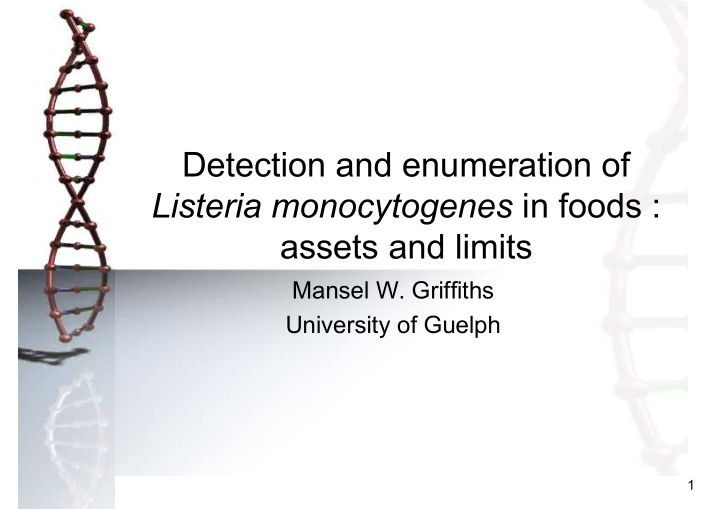



Detection and enumeration of Listeria monocytogenes in foods : assets and limits Mansel W. Griffiths University of Guelph 1
What do we need to detect? • Listeria spp. – Environmental monitoring – USDA regulations • Listeria monocytogenes – Foods • Listeria monocytogenes – human pathogens – Foods – Clinical samples
What test attributes do we need? • Sensitive and specific • Speed • Precision and accuracy • Easy-to-use • Cost effective • Approved by regulatory agencies
Culture–based 4
Environmental testing • Paradigm PDX 24 - The 24 Hour Test for Listeria in Environmental Samples • Esculin hydrolysis • Swab based
Chromogenic agar - Oxoid • ∃ -glucoside chromogen cleaved by ∃ -glucosidase, common to all Listeria • blue/green colonies • Phospholipase in L. monocytogenes (and pathogenic L. ivanovii ) hydrolyses lecithin producing distinctive opaque white halo
O.B.I.S. (Oxoid Biochemical Identification Systems) • All Listeria species except L. monocytogenes , possess D- alanyl aminopeptidase (DALAase) activity. • O.B.I.S. mono detects this enzyme using D-alanyl-7-amido- 4- methylcoumarin (DALA) • Colour appears in 20 secs and indicates that the suspect colonies are NOT L. monocytogenes
Biosys • Monitors changes in chemical characteristics of liquid medium • Reagents change spectral patterns as metabolic process takes place • Changes are detected photometrically at predetermined time intervals in a semifluid zone separated from the liquid medium
Sample preparation Pathatrix •Listeria •Listeria & Salmonella –Processes large volumes
What is currently available? Immunoassays • Automated – BioMerieux Vitek • Vidas • Mini Vidas – TECRA • Unique
What is currently available? Immunoassays • Lateral flow – Biocontrol • VIP for Listeria – Neogen • Reveal for Listeria
The future of immunoassays? • Immunoassays – Immobilize Ab on plastic film • Toxin Alert – Cheap source of Ab • Plantibodies – Patented in-situ immunoassay
In situ Immunoassays: Real-time detection in foods Organism present Organism absent
Genomics-based assays Real-Time PCR • A new generation of PCR instruments and reagents allows simultaneous amplification and quantification of specific nucleic acid sequences. • Detect the DNA generated within a PCR on a cycle- by-cycle basis. • Provides greater quantitative precision and greater convenience. • Fluorescence-detecting thermocyclers.
Detection SYBR-Green Assays • Intercalating dye • Multiplex assays for Salmonella and L. monocytogenes • Results within 1.5 h
BAX System 1. Samples enriched and treated to release DNA. 2. PCR tablets, containing all reagents necessary for PCR hydrated with lysed sample. Processed in cycler/detector to amplify a DNA fragment specific to the target. 3. The amplified DNA generates a fluorescent signal. Results displayed as +ve or -ve symbols
BAX-System • Accurate – based on DNA – simplified sample preparation procedure – automated detection • Rapid – next day results – 96 samples within 4 h after sample prep. – almost 200 tests per day, • Convenient operation and more control – standard laboratory techniques – tableted reagents – closed-tube system – simple on-screen reporting • Approved – Health Canada; FSIS; AOAC
GeneVision (Warnex Inc.) • Detection of L. monocytogenes based on real-time PCR • Molecular beacons • Approved by Health Canada • Adopted by Plumrose, Cardinal Meats
DNA Microarrays Target Probe 1 cm 2 = 25,000 probes spotted Hybridization
Evaluation: specificity testing C. parvum G. intestinalis C. cayetanensis E. coli E. coli STEC 1&2 STEC 1&2 O157:H7 Key S. typhimurium Salmonella C. coli L. mono. DT104 Dye Buffer 16S
The Future • Better methods to concentrate and remove Listeria from foods • Genetic based sensors to discriminate between pathogenic strains • Micro-fluidics devices
Recommend
More recommend